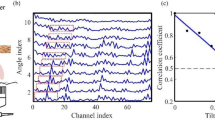Abstract
Some of the factors are considered upon which the presentation of intracranial tomograms by the ultrasonic pulse-echo technique depend. Range resolution is degraded by the increased velocity of the ultrasonic beam in the skull. Azimuth resolution is degraded by refraction when the beam does not strike the skull at normal incidence. Both range and azimuth resolution are degraded for strong reflectors when receiver sensitivity is high. The limitations imposed by these factors on the angle of scan and dynamic range of the receiver system are estimated.
Sommaire
On a étudié quelques uns des facteurs dont dépend la présentation des tomogrammes intracrâniens utilisant la technique des échos d'ultrasons. La résolution en profondeur est dégradée par l'augmentation de vitesse du faisceau d'ultrasons dans la boîte crânienne. La résolution en azimuth est dégradée par réfraction lorsque la faisceau ne frappe pas le crâne sous une incidence normale. Ces deux paramètres sont modifiés par les fortes réflexions lorsque la sensibilité du récepteur est élevée. On estime les limitations imposés par ces facteurs sur les angles d'exploration et sur l'étendue dynamique du système récepteur.
Zusammenfassung
Einige Faktoren wurden betrachtet, von denendie Abbildung intrakranieller Tomogramme mit der Ultraschall-Echo-Methode abhängt. Der Auflösungsbereich wird durch die vergrößerte Geschwindigkeit des Ultraschalls im Schädel beschränkt. Die azimutale Auflösung wird durch Refraktion verschlechtert, wenn der Strahl nicht im Normalwinkel auf den Schädel auftrifft. Die Auflösung hinsichtlich Bereich und Azimut wird bei starken Reflektoren beschränkt, wenn die Empfängerempfindlichkeit groß ist. Das Ausmaß der Begrenzungen, die durch diese Faktoren im Abtastwinkel und dem dynamischen Bereich des Empfängersystems auftreten, wird abgeschätzt.
Similar content being viewed by others
References
Baum, G. andGreenwood, I. (1958) The application of ultrasonic locating techniques to ophthalmology.Am. Med. Ass. Arch. Ophth.,60, 263–279.
Donald, I., MacVicar, J. andBrown, T. G. (1958) Investigation of abdominal masses by pulsed ulstrasound.Lancet, 1188–1195.
Greatorex, C. A. andIreland, H. J. D. (1964) An experimental scanner for use with ultrasound.Brit. J. Radiol.,37, 179–184.
Howry, D. H. andBliss, W. R. (1952) Ultrasonic visualisation of soft tissue structures of the body.J. Lab. clin. Med.,40, 579–592.
Makow, D. M., White, D. N., Wyslouzil, W. andBlanchard, J. B. (in press) A novel immersion scanner and display system for ultrasonic brain tomography. Suppl.Acta. Radiologica.
de Vlieger, M., de Sterke, A., Molin, C. E. andvan der Ven, C. (1963) Ultrasound for two-dimensional echoencephalography.Ultrasonics,1, 148–151.
White, D. N., Blanchard, J. B. andWhite, M. N. (1965) Studies in ultrasonic echoencephalography—III: Limitations of a simple radial scan.Wiss. Z. Humboldt-Univ. Berlin, Math.-Nat. R., XIV, 23–28.
Wild, J. J. andReid, J. M. (1952) Further pilot echographic studies in the histologic structure of tumors of the living human breast.Am. J. Path.,28, 839–861.
Author information
Authors and Affiliations
Rights and permissions
About this article
Cite this article
White, D.N., Clark, J.M. & White, M.N. Studies in ultrasonic echoencephalography—VII: Gdneral principles of recording information in ultrasonic B- and c-scanning and the effects of scatter, reflection and refraction by cadaver skull on this information. Med. & biol. Engng. 5, 3–14 (1967). https://doi.org/10.1007/BF02478836
Received:
Revised:
Issue Date:
DOI: https://doi.org/10.1007/BF02478836




